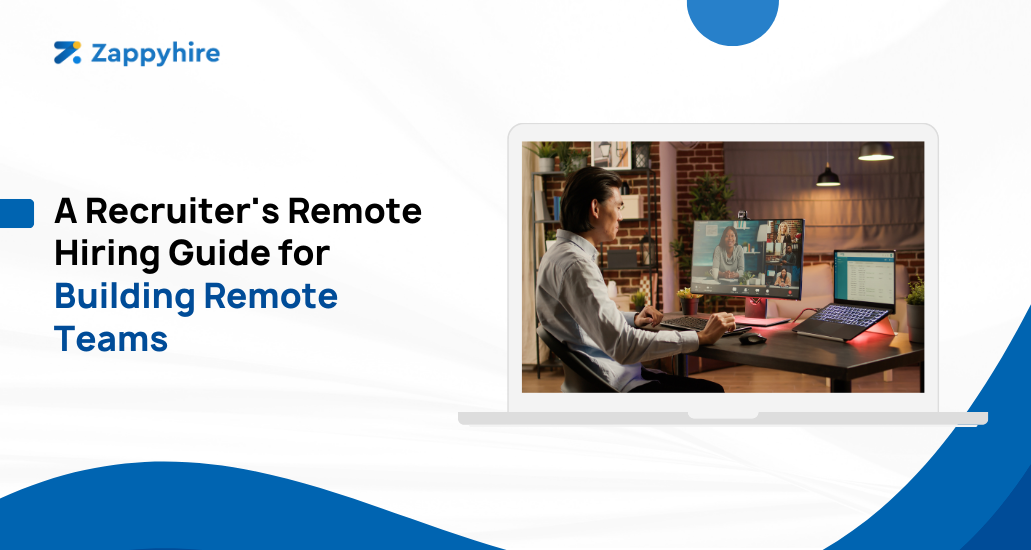
Recruiters, we understand that hiring is already a herculean task, with countless obstacles to tackle – from grappling with tight timelines to identifying top talent.
Now, imagine adding a new layer of complexity to the mix – the challenge of hiring remotely. That’s bound to come with its unique set of challenges, isn’t it?
In the dynamic landscape of today’s work culture, remote and hybrid work arrangements have become the norm, and this trend is only accelerating.
As if by design, the rise of gig workers (an independent workforce, engaged in freelance, short term, contractual or side-hustle work) have further blurred the lines of traditional employment.
Additionally, according to the World Economic Forum, Gen- Z is poised to account for one-third of the global workforce by 2025.
Notably, they have a strong preference for remote work, making it a standard employment approach.
Therefore, it all boils down to the fact that the onus is on you, recruiters, to master the art of hiring remotely, to secure top talent, and to keep pace with this ever-changing landscape.
[eBook Alert] In case you’d like to dive right into the depths of remote hiring, you may find our Ultimate Remote Hiring Kit, of even more help.

- What is remote hiring?
- How is remote hiring different from traditional hiring?
- Core factors in an effective remote hiring process
- What are the key benefits of remote hiring?
- Top remote hiring challenges faced by HR professionals and business leaders
- Vital considerations in remote hiring
- The Ultimate Remote Hiring Kit [eBook]
What is remote hiring?
The COVID-19 pandemic that brought the world to a standstill in 2020-21, may now be a part of history, but its profound impact on our work culture continues to reverberate.
It expedited a growing trend among working professionals, driven by generational shifts and the evolving work environment.
Remote hiring, also known as virtual or distributed hiring, is the practice of hiring remote employees, i.e., employees who work remotely, often from diverse geographic locations, far removed from the traditional office setup. This dynamic approach to talent acquisition is becoming increasingly integral to modern businesses’ success, and its prevalence shows no sign of waning any time soon.
But how is remote hiring different from traditional hiring?
For starters, remote hiring involves a thorough assessment to determine various factors such as, if a job can be done offsite, candidate personality, etc.
It also requires the creation of comprehensive policies and guidelines that emphasize adaptability and the management of different time zones.
On the other hand, traditional hiring just generally assumes that work will be done within the confines of a traditional physical office and makes arrangements accordingly.

It is however interesting to note that according to the “State of Remote Work 2023” report by Buffer, an impressive 98% of respondents expressed their preference for remote work at some point in their careers, up from 97% in 2022.
The above statistic speaks volumes about the lasting appeal and relevance of remote work, all thanks to the numerous benefits associated with the same.
Core factors in an effective remote hiring process
The remote hiring process involves several key steps, including:
- Job posting: Create detailed job descriptions, where emphasis is laid on the role being remote, and post job listings on relevant platforms.
- Resume screening: Just like with traditional hiring, resumes are reviewed to shortlist candidates based on the candidate’s qualifications.
- Virtual interviews: Video interviews are conducted to assess candidates’ skills and qualifications.
- Skill assessments: Online assessments are implemented to evaluate candidates’ technical or job-specific skills.
- Reference checks: Candidates’ backgrounds are verified and checked including previous work experiences.
- Onboarding: It is important to provide a simple yet comprehensive onboarding process to ensure new remote employees have the right tools and training they need to succeed and grow within the organization.

What are the key benefits of remote hiring?
Remote hiring offers an array of benefits, making it a transformative practice for organizations. Among its key benefits are:
- Cost savings:
An effective practice that saves an organization some big bucks would definitely find ‘cost savings’ among the top benefits that come with its adoption.
The proof?
A recent study revealed that employers can save up to $11,000 per employee when transitioning to remote work.
This creates substantial financial benefits, owing to decreased overhead costs, such as office space and utilities.
- Flexibility and adaptability:
Remote hiring permits a flexible approach, remaining resilient in the face of changing circumstances such as natural disasters, market expansion, and more.
This adaptable strategy extends beyond the realm of family plans, emergencies, and personal life goals, fostering better work-life balance and accommodating factors like travel options during work.
As it ensures only minimal disruption to one’s operations, remote hiring has an edge over traditional hiring as its adaptability ensures business continuity and resilience.
- Access to a global talent pool:
One of the greatest advantages that comes along with remote hiring is the fact that it gives organizations access to a global talent pool by breaking down geographical barriers.
This expansion of talent resources can bring fresh perspectives and enhanced capabilities to your team.
- Increase in employee satisfaction:
The higher the workplace flexibility enjoyed by an employee, the higher the employee satisfaction.
The flexibility that comes along with remote work contributes to higher job satisfaction and improved work-life balance, thereby promoting a positive and motivated workforce.
A study by McKinsey & Company revealed that job seekers highly value having autonomy over where and when they work, a testament to the aforementioned statement.
- Diverse and inclusive teams:
When organizations have the liberty of hiring for remote teams, they have the opportunity to build a diverse workforce as they can now hire talent from different locations and backgrounds.
This diversity can enhance innovation and creativity within the organization, thereby boosting organizational success.

Top remote hiring challenges faced by HR professionals and business leaders
Recruitment challenges for recruiters are countless, and the shift towards remote hiring introduces a new set of complexities for HR professionals and business leaders to navigate.
Some key challenges include:
- Rising proxy interviews:
With the increase in proxy interviews, where someone participates on behalf of a candidate, organizations must implement stringent measures to verify candidate identity and authenticity.
- Communication challenges:
Dependency on technology and differences in time zones can lead to misunderstandings and potential delays in the hiring process, which could impact the overall time-to-hire.
- Lack of in-person collaboration:
The absence of face-to-face interactions may hinder spontaneous hiring collaboration among team members.
It is crucial for HR professionals and business leaders to address the same, as not being on the same page can lead to significant bottlenecks in the recruitment process.
Leveraging a recruitment automation tool with capabilities as advanced as Zappyhire can help facilitate collaborative hiring at your organization.
For a deeper dive into the top recruitment software options of 2023, be sure to check out our list of the 10 best recruitment software solutions.
- Security and data risks:
Remote hiring can introduce cybersecurity risks, demanding robust security measures to safeguard sensitive information.
It’s worth noting that nearly 73% of executives believe remote workers pose a greater security risk compared to the on-site employees.
Despite the above-mentioned challenges, certain numbers suggest that it increasingly seems like a standard practice among organizations to hire remotely.
Studies have revealed that at present, around 93% of employers plan to continue conducting job interviews remotely and around 16% of organizations are already fully remote, operating without a physical office.

Vital considerations in remote hiring
Recruiters and organizations must carefully consider various factors when opting for remote hiring, including:
- Role suitability:
Not all job roles are equally suited for remote work, and recruiters must be able to evaluate the nature of each position and make a judgment call on whether or not the job can be performed remotely.
- Technology and infrastructure:
Without proper technology, facilities, and infrastructure, it may not be possible to execute remote hiring and remote work without hiccups.
It is crucial to ensure that remote employees have access to the necessary technology and infrastructure for effective remote work.
- Communication and collaboration tools:
We’ve said it before, but communication is key!
Investing in the right tools such as Slack, Google Meet, or Zoom to facilitate seamless communication and collaboration amongst remote hiring team members and remote teams is crucial.
- Performance evaluation:
Another crucial consideration to make before implementing remote hiring is to establish clear performance metrics and evaluation criteria for remote employees, focusing on outcomes rather than hours worked.
The Ultimate Remote Hiring Kit [eBook]
Now that we’ve explored the landscape of remote hiring, it’s imperative to really understand the different components when it comes to hiring remotely.
In this comprehensive eBook, you’ll find a treasure trove of insights and strategies to cope with the unique challenges remote hiring presents and make the most of the benefits it offers.
It is guaranteed to serve as your expert guide through the intricate world of remote hiring, providing you with practical remote hiring tips and actionable advice to excel in your recruitment process.

To wrap things up
Remote hiring is more than a trend; it’s a smart and convenient choice for both employers and employees. Yes, it brings a few challenges, but challenges are part of progress.
With the right remote hiring tools, such as an advanced Applicant Tracking System like Zappyhire, overcoming these challenges would be an absolute breeze!
As we look ahead, quicker adoption of the right hiring technology to stay ahead with the rapidly changing times would be key for HR professionals.
This will be the cornerstone for staying competitive and attracting fresh and top talent who are tech-savvy.



